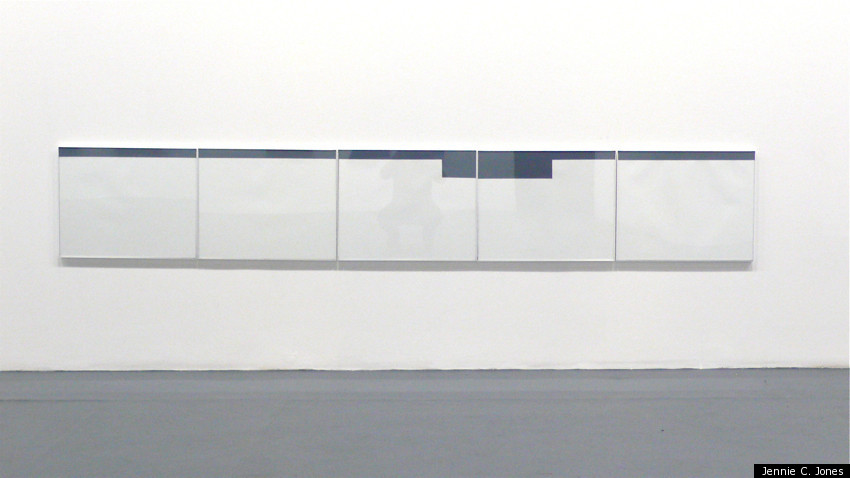
Jennie C. Jones' works address absence. Yet instead of treating absence as pure lack, Jones explores its texture, its logic, its intention, its residue. This ideological aesthetic defines Jones' work in visual arts, sound art, art history, music history and African American history.
Jones explores the absence of an African American influence in the modernist aesthetic. Through tracing a connection to avant-garde jazz, Jones navigates and sculpts collective memory to illuminate a culturally inclusive look at modernism. Her work is minimalist, formalist and clean, as restrained as it is cool. Working in the fluid region between visual and aural art, a single Jones exhibition contained sculptures of tangled cables to a sound sculpture that combines Miles Davis' 'In A Silent Way' and John Cage's '4'33.'
We asked Jones a few questions about her work, its intention and its effects. Like the works she creates, Jones is creative with her boundaries, passionate yet understated.
...
You worked mainly with visual arts for a while before transitioning into sound. Do you have music training? How separate do you see these two media?
I have a great ear, and I'm an obsessive listener, but quit every instrument I tried to learn as a kid--instead of the rigor involved with practice I wanted the freedom found in drawing. I love music notation as mark making and the language of it.
Some of your works address the loss of music's tangible physicality with the digital age. You've also spoken with-- correct me if I'm wrong-- a less-than-enthusiastic impression of postmodernism. What do you think of the current cultural climate in contrast to the modernist era? Do you think modernism still lives and thrives today?
Post-modernism encompasses so much the word is kind of meaningless I think under a conceptual heading I'm interested in "neo modernist"-- a term that has been used to describe a philosophical position based on modernism but addressing the critique of modernism by postmodernism--one hell of a loop.
Regarding the digital age aspect to your question, when I was a kid the broadcast day ended, and there was a place for silence. I think with analogue there is effort and ritual involved, even if it's just lifting a needle or turning a tape over. Now I can set Pandora and walk away for like 6 hours of listening, there is no end to our broadcast day, no silences, very little touch or physical interaction--how we listen has totally changed. We block ambiant 'noise' out with earbuds and headphones. When I edit sound pieces I am very aware of the gift a rest can be, the breath in between, the poetic pause.

You have spoken about feeling uncomfortable with your modernist aesthetic because it was somehow at odds with being an African American. It is odd to think about an aesthetic inclination appealing more to a certain ethnic group or culture... Why do you think this is? Do you think taste has to do with tradition and surroundings or is it more internal and instinctive?
I would not say at odds, I hope that my work can point out the parallel relationships between the "social practices" of black music at mid-century (and beyond) as well as its overt connection to dominant visual "isms" historically. What's more that it presents a place for that discourse to expand. As I attempt to reconcile these counterparts/influences that are present in my work, lately I keep thinking about two things:
1. The gesture of Miles Davis facing away from the audience when he played, and
2. President Obama needing to show the world his birth certificate.
One says f*** you I'm doing my thing, my way the other says, regardless of my accomplishments I still have to show you my papers, be validated, somehow seek permission or have proof. That could be the crux of a critical essay to be written about black abstraction. I am waiting for that text; I don't have the skills for scholarly writing but I could provide a table of contents! This is all a huge conversation to be had, huge. I think another thing to address is this demand for transparency from African American artists, that is not expected from all makers in the art world, there is a real inequity there. I think that could be the moment when you turn your back to the audience like Miles. In terms of 'aesthetic inclination' I believe that to be more personal than based on ethnicity or identity. These are issues that go back as deep as the Harlem Renaissance and will stretch far beyond my lifetime.

Your work seems to ask your audience to listen closely to silence, to look closely at absence, and this does seem to connect the minimalist aesthetic with your mission to address the absence of African American influence in modernist art. Do you see history as an art form as well?
Presence, absence and intention are huge aspects of my work and metaphorically reflect my interest in history. There is a poetic nature to minimalism that is about striking a balance between full and empty. I think abstraction can be off putting, still, sadly, yet it's a subjective space. A simple line or single extended note could have a weight and simultaneous lightness. Something being busy or crowded does not make it more fulfilling to me.
My use of minimalism in a sense is also about and commenting on the language of the cannon while also often repurposing materials. It is my natural aesthetic inclination but I hope to use it as well to talk about issues of formalism, expectation and to be honest about my experience - which includes art school.
A recent review in a major art magazine called the work inaccessible--rendering mute the read that a black woman, making black paintings that absorb and soften the sound in a room is not a conceptual/political or for that matter a personal gesture. It is hard to work outside of the figurative narrative mode, it is often isolating and takes courage but I would hope that there is room for all modes of creative expression in 2012. Abstraction and minimalism, for me, are radical acts. I cannot, nor should I ignore my relationship to it. If I need pedagogy to back it up outside of art history, I feel I have it in Ornette Coleman, Cecil Taylor, Mingus, Monk etc. That's me showing 'my papers'! The sound pieces keep evolving because of their legacy, even as I stretch beyond direct references to jazz with a capital J.
Sometimes it seems I fell out of the sky, but to me it seems more about how blatantly we ignore the intricacies of history, the constant cultural crossovers, exchanges and co-opting.

